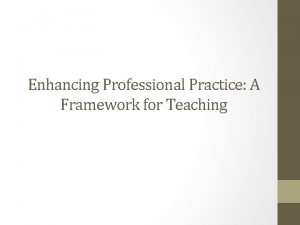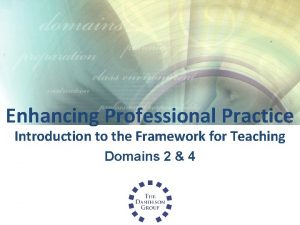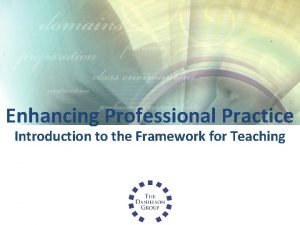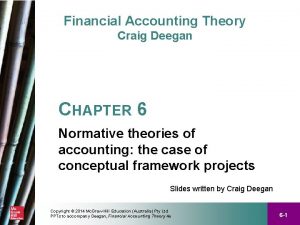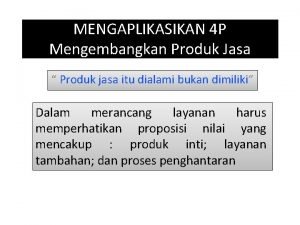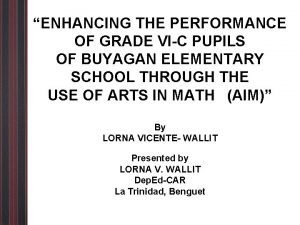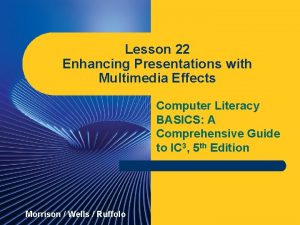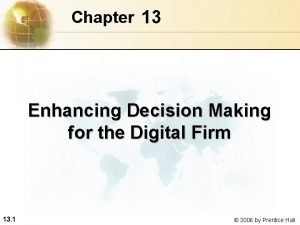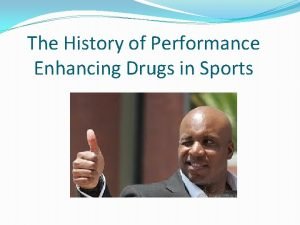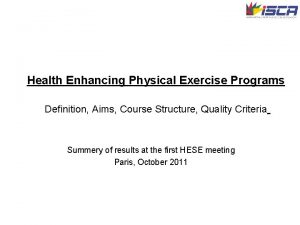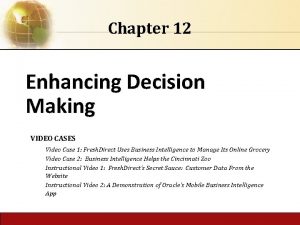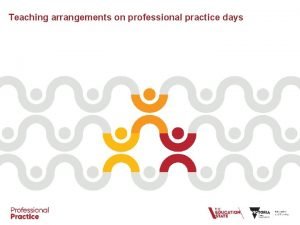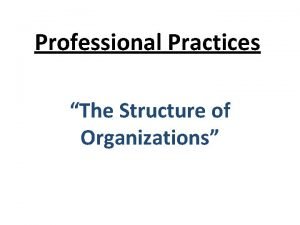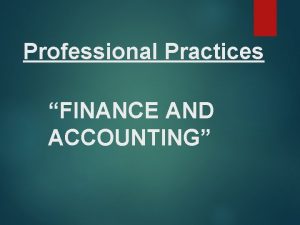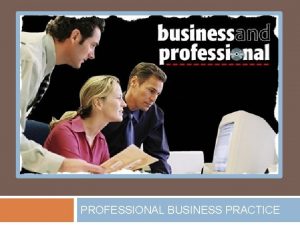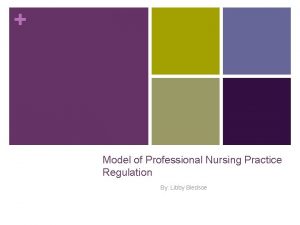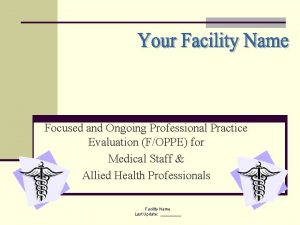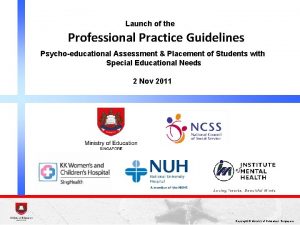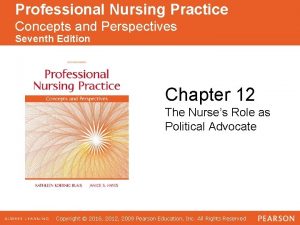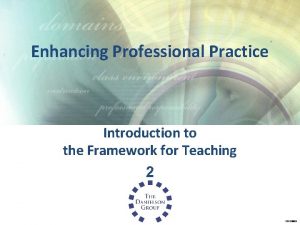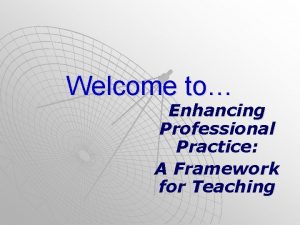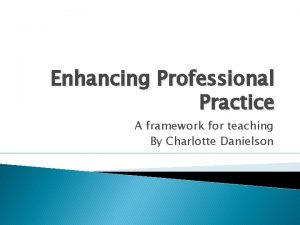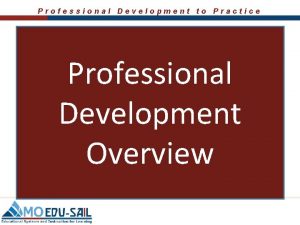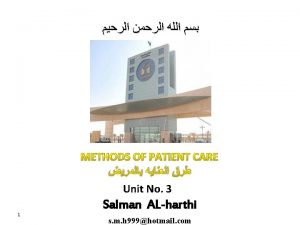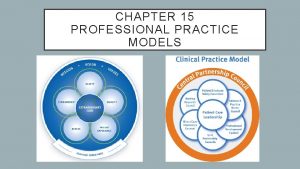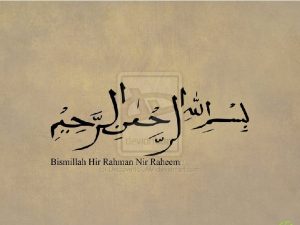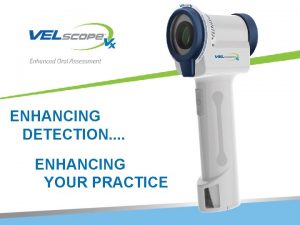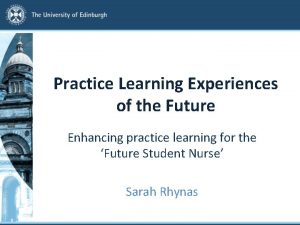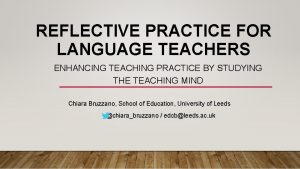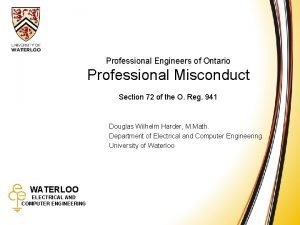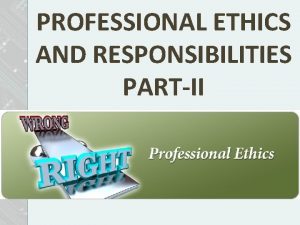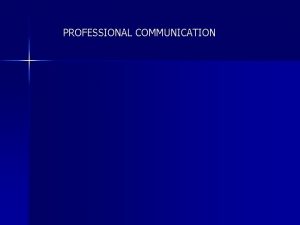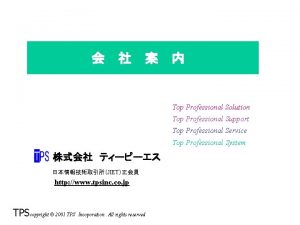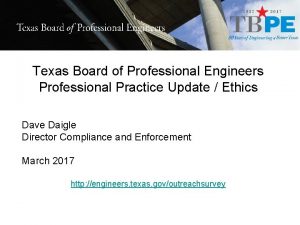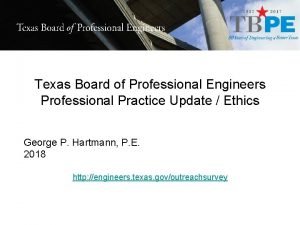Enhancing Professional Practice Introduction to the Framework for


























- Slides: 26

Enhancing Professional Practice Introduction to the Framework for Teaching

Outcomes An introduction to the Danielson Framework as a tool for examining and improving teaching practice • Understand the structure and the language of the Framework for Teaching • Know the domains and components of the Framework for Teaching • Identify the essential characteristics of each of the Framework’s levels of performance • Generate examples of classroom practice

Agenda What is good teaching? ICE BREAKER Overview Teachscape & My Learning Plan Overviews Domain 1: Planning and Preparation Activity 10 Domain 3: Instruction o Activity 9 • Reflection • Save the dates: THIS IS YOUR REMINDER TO FACULTY • • •

Norms Equity of voice Attentive listening Safety to share different perspectives Commitment to the work

Domain 1 Planning and Preparation Domain 2 Classroom Environment 1 a 1 b 1 c 1 d 1 e 1 f 2 a 2 b 2 c 2 d 2 e Demonstrating Knowledge of Content & Pedagogy Demonstrating Knowledge of Students Setting Instructional Outcomes Demonstrating Knowledge of Resources Designing Coherent Instruction Designing Student Assessment Creating an Environment of Respect & Rapport Creating a Culture of Learning Managing Classroom Procedures Managing Student Behavior Managing Physical Space The Danielson Framework for Teaching Domain 4 Professional Responsibilities Domain 3 Instruction 4 a 4 b 4 c 4 d 4 e 4 f 3 a 3 b 3 c 3 d 3 e Reflecting on Teaching Maintaining Accurate Records Communicating with Families Participating in a Professional Community Growing and Developing Professionally Showing Professionalism Communicating with Students Using Questioning and Discussion Techniques Engaging Students in Learning Using Assessment in Instruction Demonstrating Flexibility & Responsiveness

The Framework for Teaching 4 Domains 22 Components 76 Elements DOMAIN = 3. Instruction COMPONENT = ELEMENT = c. Engaging Students in Learning Grouping of Students

Levels of Performance • UNSATISFACTORY: TEACHING SHOWS EVIDENCE OF NOT UNDERSTANDING THE CONCEPTS UNDERLYING THE COMPONENT • MAY REPRESENT PRACTICE THAT REQUIRES INTERVENTION • BASIC: TEACHING SHOWS EVIDENCE OF KNOWLEDGE AND SKILLS RELATED TO TEACHING-BUT INCONSISTENT PERFORMANCE DUE TO LACK OF EXPERIENCE • PROFICIENT: TEACHING SHOWS EVIDENCE OF THOROUGH KNOWLEDGE OF ALL ASPECTS OF THE PROFESSION. STUDENTS ARE ENGAGED IN LEARNING. THIS IS SUCCESSFUL, ACCOMPLISHED, PROFESSIONAL, AND EFFECTIVE TEACHING. • DISTINGUISHED-CLASSROOM FUNCTIONS AS A COMMUNITY OF LEARNERS WITH STUDENT ASSUMPTION OF RESPONSIBILITY FOR LEARNING

Levels of Performance UNSATISFACTORY BASIC PROFICIENT DISTINGUISHED Lack of Unsafe Harmful Unclear Unaware Poor Unsuitable Inconsistent Partial General Attempts Awareness Moderate Minimal Consistent Frequent Successful Appropriate Clear Positive Smooth Solid Seamless Subtle Skillful Preventative Leadership Students TEACHER DIRECTED SUCCESS STUDENT DIRECTED SUCCESS

Good Teacher Project While watching and listening to the videos, “How would your students respond to the questions? ” http: //www. youtube. com/watch? v=13 d. Xvqdo. Rx 0&feature =em-share_video_user http: //www. youtube. com/watch? v=4 f. NOg. XJT 3 c&feature=em-share_video_user

What Does Evidence Look Like? ACTIVITY SMALL GROUPS WILL IDENTIFY EVIDENCE FOR THE COMPONENTS IN DOMAIN 1 Ø Divide participants into six groups. Ø Each group identifies evidence for each of the elements in that component (1 a, 1 b, etc. ). Ø Groups then share out.

Domain 1: Planning and Preparation Activity 10 With your partners, discuss the video and relate it to the remaining components in Domain 1. As you discuss the components, refer to the elements to inform your thinking: 1 a Knowledge of Content and Pedagogy: p. 47 1 b Knowledge of Students: p. 49 1 d Knowledge of Resources: p. 56 1 c Setting Instructional Outcomes: p. 54 1 f Designing Student Assessments: p. 63 Complete the concept map that indicates the relationship of each component to 1 e: Designing Coherent Instruction. How do the other components in Domain 1 support the design of engaging student activities? Handout page 19

“Look Fors and Listen Fors” in Components of Charlotte Danielson’s Framework for Professional Practice • Domain 1: Planning and Preparation Component 1 a: Demonstrating Knowledge of Content and Pedagogy Knowledge of content and the structure of the discipline Knowledge of prerequisite relationships Knowledge of content-related pedagogy • Look Fors and Listen Fors: Lessons based on current best practice Advanced courses in content and techniques Instructional artifacts (evidence in the form of student work products with comments) Instructional interactions with students

“Look Fors and Listen Fors” in Components of Charlotte Danielson’s Framework for Professional Practice • Domain 1: Planning and Preparation Component 1 b: Demonstrating Knowledge of Students • Knowledge of child and adolescent development • Knowledge of the learning process • Knowledge of students’ skills, knowledge, and language proficiency • Knowledge of students’ interests and cultural heritage • Knowledge of students’ special needs Look Fors and Listen Fors: • Inventories, surveys and communications to families are used to gather information about students at the beginning of the year. • Uses school records, i. e. test scores, permanent records, IEP’s etc. as primary sources of knowledge of students. Uses secondary sources such as conversations with prior teachers and other school personnel. • Class description that appropriately classifies students by learning abilities and other indicators (2 nd language, other ethnic-cultural issues, special needs – both medical, social and educational)

“Look Fors and Listen Fors” in Components of Charlotte Danielson’s Framework for Professional Practice • Domain 1: Planning and Preparation Component 1 c: Setting Instructional Outcomes Value, sequence, and alignment Clarity Balance Suitability for diverse learners Look Fors and Listen Fors: Goals are age/level appropriate Goals are suitable for diverse learners Goals = what students will learn as opposed to lesson objectives which = what students will know, understand, and be able to do Goals can be assessed

“Look Fors and Listen Fors” in Components of Charlotte Danielson’s Framework for Professional Practice • Domain 1: Planning and Preparation Component 1 d: Demonstrating Knowledge of Resources for classroom use Resources to extend content knowledge and pedagogy Resources for students Look Fors and Listen Fors: Resources to assist teaching and/or help students, i. e. texts, instructional aids, field trips, experts from community, programs/experiences, technology Knowledge of a range of resources, services and aids

“Look Fors and Listen Fors” in Components of Charlotte Danielson’s Framework for Professional Practice • Domain 1: Planning and Preparation Component 1 e: Designing Coherent Instruction Learning activities Instructional materials and resources Instructional groups Lesson and unit structure Look Fors and Listen Fors: In Unit Plans – at least three weeks with daily topics and activities that reflect organization and sequencing, and variety of materials and groups In Lesson Plans – description of students, instructional objectives, assessments, activating, cognitive, and summarizing strategies, materials, and potential misunderstandings Grouping patterns with a student focus: • Low – teacher or student leads large group, students work in small groups while teacher circulates; students work alone, teacher monitors • Moderate – teacher works w/ small groups; students work alone or in small groups • High – student lead presentations or other leadership roles within a structured lesson

“Look Fors and Listen Fors” in Components of Charlotte Danielson’s Framework for Professional Practice • Domain 1: Planning and Preparation Component 1 f: Designing Student Assessment Congruence with instructional outcomes Criteria and standards Design of formative assessments Use for planning Look Fors and Listen Fors: Methods of assessing each goal: tests, data analysis, production of findings, collaboration Scoring systems/rubrics establishing measurable criteria are communicated up front Authentic, real world applications are evident Feedback to students guide next steps, i. e. teaching or re-teaching

Knowing 1 a Content & Pedagogy Doing 1 c Instructional Outcomes 1 b Students 1 f Designing Assessments 1 d Resources 1 e Designing Instruction

What Does Evidence Look Like? ACTIVITY SMALL GROUPS WILL IDENTIFY EVIDENCE FOR THE COMPONENTS IN DOMAIN 3 Ø Divide participants into five groups. Ø Each group identifies evidence for each of the elements in that component (3 a, 3 b, etc. ). Ø Groups then share out.

“Look Fors and Listen Fors” in Components of Charlotte Danielson’s Framework for Professional Practice Domain 3: Instruction Component 3 a: Communicating with Students • Expectations for learning • Directions and procedures • Explanations of content • Use of oral and written language Look Fors and Listen Fors: • Clear directions and explanations (oral and written) • Vivid, expressive language is used to enhance student experience • Clear limits are set, , including time factors • Language is audible, legible; correct usage, spelling, etc. is apparent • Teacher carefully chooses words, using rich vocabulary for students to model

“Look Fors and Listen Fors” in Components of Charlotte Danielson’s Framework for Professional Practice Domain 3: Instruction Component 3 b: Using Questioning and Discussion Techniques • Quality of questions • Discussion techniques • Student participation Look Fors and Listen Fors: • Essential question is posted for each lesson; question is asked by teacher and answered by students throughout the lesson • Questions engage students in an exploration of content, are not rapid fire, low level, recitation of facts • “Think time” is allowed before responses • Teacher probes to seek clarification, i. e. “explain…. ”, “give an explanation for…” • All students are engaged in discussion; not just a few, students often take initiative • Teacher stays on topic, uses follow-up, rephrases and applies what students contribute or pose

“Look Fors and Listen Fors” in Components of Charlotte Danielson’s Framework for Professional Practice Domain 3: Instruction Component 3 c: Engaging Students in Learning • Activities and assignments • Grouping of students • Instructional materials and resources • Structure and pacing Look Fors and Listen Fors: • Instructional artifacts – student work, out of class assignments • Teachers uses of examples and metaphors that illustrate new learning; teacher connects with student knowledge, interests and culture • Teacher promotes problem-solving; permits choice, encourages depth-find patterns, tests hypotheses, requires thought; is relevant and authentic • Groupings are based on instructional goals • Materials and resources are ready for student use with little or no disruption • Structure of lesson is maintained; pacing is appropriate with a beginning, a middle, and end (closure)

“Look Fors and Listen Fors” in Components of Charlotte Danielson’s Framework for Professional Practice Domain 3: Instruction Component 3 d: Using Assessment in Instruction • Assessment criteria • Monitoring of student learning • Feedback to students • Student self-assessment and monitoring of progress Look Fors and Listen Fors: • Teacher and peer comments on student work • Teacher uses body language such as nods, quizzical looks, etc. to encourage students • Effective feedback that is specific, descriptive, understandable; Feedback is not praise (“good work” or “good job), grades, encouragement (“Keep it up” or “You can do it) or criticism (“Unacceptable…You get a zero”) • Comments give students information needed to adjust what they are doing and get better at it or solve a problem; it provides time to think and reflect; performance is related to standards • All feedback is provided in a timely fashion, “on the spot”, or on work products, as needed to support learning

“Look Fors and Listen Fors” in Components of Charlotte Danielson’s Framework for Professional Practice Domain 3: Instruction Component 3 e: Demonstrating Flexibility and Responsiveness • Lesson adjustment • Response to students • Persistence Look Fors and Listen Fors: • Adjustments that improve student experience or clarify confusion • Change provides for needs specific learners (visual, auditory, slower, brighter, etc. ) • Teacher abandons lesson all together or coordinates with a spontaneous event • Teacher possesses an extensive repertoire of strategies such that transitions are seamless; students may not be aware that a change has occurred

Connecting Design with Engagement COMPONENT 1 e Designing Coherent Instruction COMPONENT 3 c Engaging Students in Learning • Learning Activities • Activities and assignments • Instructional materials and resources • Instructional groups • Grouping of students • Lesson and unit structure • Structure and pacing

In order to help us better address your needs, please complete the evaluation on My Learning Plan with in the next few days. Thank you! REFLECTION Save the dates: ? ?
 Enhancing professional practice a framework for teaching
Enhancing professional practice a framework for teaching Enhancing professional practice
Enhancing professional practice Charlotte danielson framework
Charlotte danielson framework Four enhancing qualitative characteristics
Four enhancing qualitative characteristics Enhancing personal effectiveness
Enhancing personal effectiveness Enhancing supplementary services
Enhancing supplementary services Enhancing thermal conductivity of fluids with nanoparticles
Enhancing thermal conductivity of fluids with nanoparticles Enhancing the performance of grade vi-c
Enhancing the performance of grade vi-c Privacy-enhancing computation
Privacy-enhancing computation Property enhancing processes
Property enhancing processes Enhancing a presentation with multimedia
Enhancing a presentation with multimedia Enhancing decision making
Enhancing decision making History of performance enhancing drugs
History of performance enhancing drugs Health enhancing definition
Health enhancing definition Enhancing decision making
Enhancing decision making Ifpp framework
Ifpp framework Professional practice days
Professional practice days Structure of organization in professional practice
Structure of organization in professional practice Professional practice finance
Professional practice finance Professional nursing practice concepts and perspectives
Professional nursing practice concepts and perspectives Professional business practice
Professional business practice Model of professional nursing practice regulation
Model of professional nursing practice regulation Focused professional practice evaluation
Focused professional practice evaluation Tpess training
Tpess training Moe professional practice guidelines
Moe professional practice guidelines Professional nursing practice concepts and perspectives
Professional nursing practice concepts and perspectives It is to conform to accepted professional practice
It is to conform to accepted professional practice
